Native Fish Policy
Introduction
Fly Fishers International (FFI) notes that throughout North America native fish populations have declined from historical levels, particularly over the last century or more, due to the cumulative effects of over-harvest, water management, past fisheries management practices, agricultural, forestry, and mining, and other land use practices, habitat alteration or degradation, and the widespread introduction of non-native fish species. The goal of many fisheries management agencies and programs today is to preserve or restore native fish species to some portion of their historical native range. These goals have been driven by the legal mandates of the Endangered Species Act (ESA) and by the increased value that anglers, fisheries managers, conservation organizations, and other concerned individuals place on native fishes in native habitats.
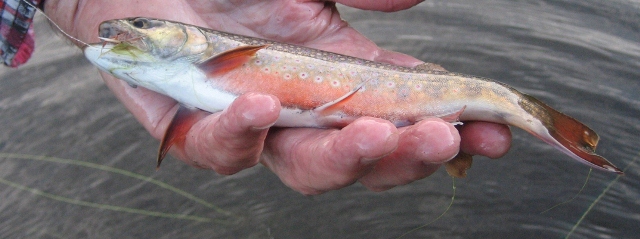
Brook Trout
FFI established a Native Fish Policy that set forth clear principles to assist our members, clubs, and councils speak with a consistent voice on management or legislative actions that may affect native fish populations, such as a proposal to restore endemic fish populations to historical habitat. A growing number of proposed restoration projects for game and non-game species challenge our ethics as sport anglers when we must choose between a popular non- native sport fishery and a conflicting imperative to restore native fish or amphibians. The Native Fish Policy recognizes that many proposed restoration projects are controversial among the angling community. It also recognizes that flexibility is required to assure sound management of native fisheries, while maintaining compatible recreational fishing opportunities for all anglers.
Most importantly, a Native Fish Policy maintains and strengthens FFI's moral responsibility to advocate for balanced multiple-use in natural resource development on our public lands and to guard against management practices that may threaten native species and the aquatic environments we treasure. It affirms our support for the Endangered Species Act and its provisions for protecting imperiled fish and wildlife species and their habitats.
FFI Native Fish Policy establishes a guiding philosophy of FFI regarding conservation of native fish and their habitats. The policy generally addresses coldwater fisheries, but additional specific policies have been developed for steelhead, saltwater fishes, and warmwater fishes.
Native Fish Policy Statement

Cutthroat Trout
1. FFI supports fisheries management policies and practices that recognize the value of native species and their conservation in native habitats, and does not support management policies that threaten native species with degradation or extinction. Similarly, FFI does not support the stocking of non-native fish into waters where they can interact genetically, behaviorally, or ecologically with native fish species (1).
2. FFI recognizes the intrinsic value of native fish species and their aquatic communities. FFI supports management policies and practices that promote scientifically sound management and restoration of self-sustaining populations of native fish and other native aquatic species. A tremendous recreational value to flyfishers is lost when these species are no longer available in population densities capable of supporting a sustained fishery.
3. FFI recognizes that many native fish species, particularly salmonids, are remarkable for the diversity they display in their behavioral, ecological, and genetic characteristics. The biological diversity that occurs within various fish species is a natural response to the habitat diversity they encountered in the landscape where they lived and evolved. The ecological community where they evolved, which included their predators, prey and competitors, also shaped the diversity we observe in fish species today. Human activities over the last several centuries have dramatically altered aquatic ecosystems and reduced aquatic habitat diversity and biological diversity within native fish species.
4. FFI supports management programs and actions that promote the restoration of diverse habitats that support native fish species. A corresponding increase in life history diversity within the population is likely to occur where native fish exist in or are reintroduced to these diverse habitats, as adaptation and evolution are continuing processes. Increases in abundance, age class diversity, and life history diversity within a population leads to resilience, which in turn fosters a self-sustaining population.
5. FFI is concerned about the continued erosion of the genetic integrity of existing native fish populations and supports management decisions that prioritize the protection of existing native populations. FFF supports careful stream censuses of fish diversity to identify genetically intact native fish populations and supports management decisions and actions that ensure these populations are preserved in perpetuity and remain geographically isolated from non-native species.
6. FFI supports the establishment of native fish refuges or conservation areas where meta- populations of genetically healthy native fish species occur. A system of native fish conservation areas throughout the country would act as an insurance policy for fisheries managers by providing non-introgressed native fish stocks that could be used for transplants, re-introductions, or other recovery efforts (2).
7. FFI supports an approach to native fish species restoration that advocates habitat and watershed protection and restoration of the natural ecological processes that maintain the native fish species’ evolution. This approach may include a limited role, if any, for use of hatchery production in the restoration of native fish species. FFI approach relies on habitat restoration, control of non-native fish species, and reintroduction of native species into habitats from which they have been extirpated.
(1) In this document, the term ‘native’ refers to indigenous species and forms, and does not include non-indigenous naturally reproducing wild fish. Fisheries management throughout most of the 20th century promoted the introduction of non-native fish species. Starting in the late 1970s, managers recognized that these efforts had produced exotic fisheries with considerable recreational value to fishers, but at great expense to many native fish species. Thus, the FFF policy, while recognizing the value of these non-native based fisheries, places greater priority on managing and rebuilding fisheries throughout the country that support native fishes in their native habitats. In this context, we treat the terms non-indigenous and exotic as synonymous with non-native.
(2) See FFI Native Fish Conservation Area Policy. The methods and philosophies of these conservation areas are described therein as a way to protect and restore native assemblages of aquatic species.
8. FFI supports the recovery of native fish species into at least a portion of their historical ranges. The recovery goal would be to achieve and maintain viable fisheries or populations of native fish within their native streams. This may require the removal of introduced non-native species from specific streams in some cases and the subsequent transplanting of native fish from nearby remnant populations. FFI supports carefully managed application of pesticides where required to achieve the restoration project goal.
Recovery programs may require the use of hatchery production from remnant stocks to achieve recovery objectives in cases where transplanting from adjacent stocks is not feasible, such as occurred with the Gila trout. Such programs should be of limited duration until adequate populations have been restored into native habitats.
The restoration of native fish species into at least a portion of their historical ranges, should be used judiciously and will be most useful in recovering critically depressed stocks, such as ESA-listed endangered, threatened, or sensitive stocks (the latter also called Species of Concern by some state agencies). Most of the cutthroat trout subspecies, for example, fall into one of these categories. The approach is one of several tools that can be used to reestablish viable populations of native fish species in their native habitats to protect their persistence into the future. These programs or actions likely would be site-specific or species-specific and will require careful consideration by regional biologists and fish managers to improve the likely success of the transplantation effort.
9. FFI recognizes the impact that non-native fish introductions have had on native fishes and opposes any unauthorized introductions or transplants of fish species into aquatic systems. The widespread stocking of hatchery rainbow trout for example has impacted populations of interior redband trout, nearly all interior cutthroat trout subspecies, and eastern brook trout. Further, the introduction of hatchery largemouth bass has threatened native Guadalupe bass in regions of the southwest. Similarly, transplants of fish into previously fishless systems (or above natural fish barriers) have severely impacted indigenous amphibian diversity.
10. FFI recognizes the responsibility anglers have to avoid spreading pathogens (such as whirling disease and viral hemorrhagic septicemia) and non-indigenous nuisance or invasive species (such as quagga mussels or Eurasian milfoil) among watersheds. Anglers should take care to inspect their equipment (waders, boots, float tubes, boats, and trailers) for visible plants and dirt, thoroughly wash and dry their fishing equipment before moving from one watershed to another.
11. FFI recognizes that sustained management of many native fish species will require restrictive fishing regulations (including a total closure of the fishery if warranted), such as barbless hooks, slot limits, or catch-and-release angling, to reduce mortality rates that will adversely affect population structure and survival of spawning age fish. FFI supports proper catch-and-release angling techniques for native species as an important component of sustainable management (3).
12. FFI develops and provides educational materials to FFI members, other anglers, and the general public regarding the value of conserving of native fishes in our aquatic ecosystems through sound management. FFI encourages its clubs and councils to actively engage in native fish restoration projects and programs, particularly in ways that interact positively with fisheries agencies, the public, and the media. FFI members are encouraged to interact with the FFI Conservation Committee when planning native fish restoration projects, and are likewise encouraged to participate in such FFI native fish conservation awareness programs such as Project Cuttcatch and Bass Catch.
13. FFI is concerned about the negative impacts of ocean aquaculture on native wild stocks of fisheries and the condition of our aquatic environments, such as has occurred for salmon stocks in Norway, Scotland, Ireland, and British Columbia. FFI strongly recommends that policies be established that require operations of ocean aquaculture to minimize any impacts on wild fish populations. This may result in restrictions on the operation of the facility including the annual timing (presence/absence) of the aquaculture operation itself.
(3) Catch-and-release angling incurs a low level of mortality. Much of this mortality can be further reduced through proper playing, handling, and releasing of hooked fish. Anglers should use heavy enough tackle that the fish can be landed as quickly as possible. Handle the fish as little as possible, keeping it in the water; wet hands or net before landing the fish. Use long-nosed pliers or hemostat to back the hook out of the entrance hole. The use of barbless or circle hooks makes it easier to quickly unhook a fish. Hold the fish gently moving it back and forth until it revives and swims from your hands.
Original December 15, 2001. Revised March 3, 2010
Native Fish Sub-Committee IFFF National Conservation Committee
International Fly Fishers of Fly Fishers
FFI Native Fish Policy: Steelhead
FFI notes that West Coast wild (4) steelhead stocks are declining rapidly and are at high risk of demographic extinction. Most wild stocks are substantially below historical levels of abundance and the wide range of genetic and life history diversity of native stocks has been and continues to be compromised by habitat alteration, overharvest, and ill-advised hatchery practices.
FFI steelhead goals are to preserve wild steelhead genetic and life history diversity and restore wild West Coast steelhead stocks to historical abundance through habitat restoration, restrictions on sport and commercial harvest until wild populations recover, and reductions both in scope and magnitude of current hatchery stocking practices, particularly where they impact wild steelhead populations.
(4) FFI defines wild fisheries as naturally reproducing native species in their native habitats.
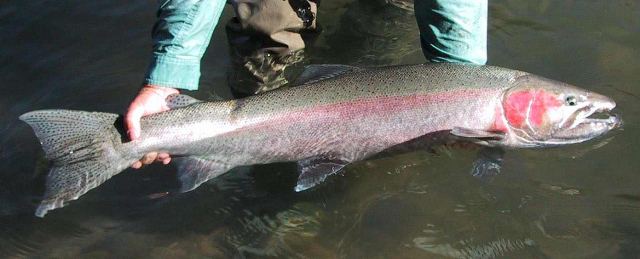
Steelhead
Steelhead Native Fish Policy Elements
1. FFI supports steelhead management that emphasizes self-sustaining wild native populations. We explicitly recognize the value and integrity of locally adapted stream/tributary specific steelhead stocks which require careful, conservative management of these irreplaceable resources giving due weight to their special habitat and escapement requirements.
2. FFI urges steelhead management agencies to accord the highest management priority to wild, stream born steelhead. Wild steelhead are at the heart of any steelhead management scheme.
3. FFI views steelhead hatchery supplementation as an admission of management failure to provide for wild steelhead. FFI urges the utmost caution in any steelhead supplementation program. Hatchery propagation should not replace or assist natural propagation of steelhead in watersheds capable of supporting viable wild steelhead.
4. FFI supports limits on angler harvest until steelhead stocks have recovered to levels that permit harvest of specific numbers of wild steelhead in each particular watershed. FFI supports catch and release using single barbless hooks and artificial flies or lures only and wild steelhead release regulations, which permit limited recreational opportunity with minimal harm, while wild stocks recover.
5. FFI supports the establishment of wild native steelhead refuges or conservation areas throughout the North American and Asian range of the steelhead. Refuges could be located where meta-populations of genetically healthy steelhead populations occur. A system of wild steelhead refuges would act as a long-term insurance policy for fisheries managers to assure future management options and assist recovery programs.
6. FFI encourages fisheries managers to sharply reduce the level of steelhead bycatch in fisheries targeting other more productive species. Because of their long freshwater rearing period (1-5 years), steelhead have limited capacity to support harvest pressure and may experience sharp declines in abundance and diversity when harvested at high levels.
7. FFI promotes the removal of hydroelectric and irrigation dams which block or hinder the migration of anadromous salmonids. In cases where removal is infeasible, fish passage and dam operation should be managed in accordance with the best available science to allow safe migration and access to historic spawning areas.
8. Healthy populations of wild salmonids rely on healthy freshwater habitat and FFI believes that as a society we must seek to better balance human population growth with the protection of river habitats. We strongly encourage the protection of remaining viable habitat through private, or public action and the restoration of degraded habitats.
9. FFI recognizes that ocean aquaculture of salmonids has negatively impacted wild salmon and steelhead stocks in various locations throughout the world. Consequently, fish farming practices must be brought into balance with the broad conservation goals of restoration and protection of wild salmon and steelhead. Therefore, until fish farming operations are regulated to reduce or eliminate the impacts to wild fish and their ecosystems; no further expansion of the industry is recommended.
10. FFI develops and provides educational materials that will increase angler awareness and understanding of the conservation and recreational values of maintaining native steelhead, and the ecological reasons for their preservation. FFI provides these materials in The Osprey: Publication of Fly Fishers International Steelhead Committee.
FFI Native Fish Policy: Saltwater Fishes
Fly Fishers International notes that problems for inshore, nearshore, and offshore marine fisheries and environments are primarily related to over-harvest due to commercial and recreational fishing, misguided management policies, lost or degraded habitats, particularly for the rearing and growth of juvenile fish, and the effects of pollution. FFI advocates vigorous, continued efforts in addressing these problems.
Further, FFI recognizes the serious problems caused by the many exotic species that have been introduced to our marine environments, intentionally or otherwise. Where these exotic species occur, we urge their control, if not their elimination. And we urge the most strenuous efforts to prevent the introduction of non-native species to our marine environments.
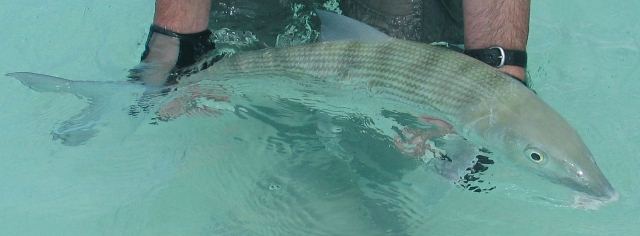
Bonefish
Saltwater Native Fish Policy Elements
1. FFI supports management of saltwater gamefish that emphasizes self-sustaining wild populations. FFI explicitly recognizes the value and integrity of geographical stock structure for many saltwater species, which requires careful, conservative management of these irreplaceable resources giving due weight to their unique habitat and survival requirements. Catch and release regulations using single barbless hooks and artificial flies or lures only provide an excellent management tool for protecting vulnerable or depressed wild populations.
2. FFI supports science-based accountability measures to manage fishery populations pursuant the 2006 re-authorization of the Magnason Stevens Act. FFI supports harvest management regulations for saltwater gamefish that ensure adequate survival and protection in spawning areas for each geographical stock. The recent collapses of important long-standing fisheries, such as the Atlantic cod fishery and the Pacific ground fish fishery, point to the inadequacy of traditional harvest management practices for the long-term sustainability of many commercially important marine fish species. FFI recognizes the value of these fisheries and supports efforts to implement more conservative harvest practices that ensure adequate survival for spawning.
3. FFI supports sharp limits on harvest (including closures) of severely depressed stocks until the stocks have recovered to levels that allow catch-and-release recreational fishing or limited and controlled harvest of specific numbers in specific locations.
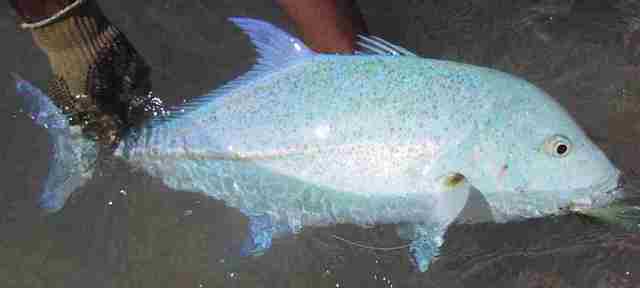
Bluefin Trevally
4. FFI explicitly opposes the introduction of non-native species to marine environments in order to preserve the indigenous species and their habitats.
5. FFI supports the establishment of marine sanctuaries or refuges where meta-populations of native species or assemblages occur.
6. FFI develops and provides educational materials that will increase angler awareness and understanding of the conservation and recreational values of maintaining native saltwater species, nearshore coastal environments, and the ecological reasons for their preservation.
FFi Native Fish Policy: Warmwater Fishes
Warmwater species have been widely distributed because of widespread stocking programs for the purpose of increasing angling opportunities in different parts of the world. FFI acknowledges the recreational value many introduced populations provide to the angling public, but also emphasizes the damage caused to native fish communities by the introductions. Proliferation of non-native fish, along with habitat disturbances, are responsible for 70% percent of the 27 fish extinctions that have been documented in North America. Non-native fish often prey on native species, or compete with them for resources such as spawning gravel and food. Loss of native biological diversity has occurred where non-native and native species have hybridized. Consequently, FFI advocates as a high priority against further introductions of non-native species or translocating any fish between watersheds. FFI realizes that managers will continue the practice of stocking warm water fish for recreational purposes, but advocates the precautionary principle of scientifically sound management whenever introductions into new waters are contemplated.
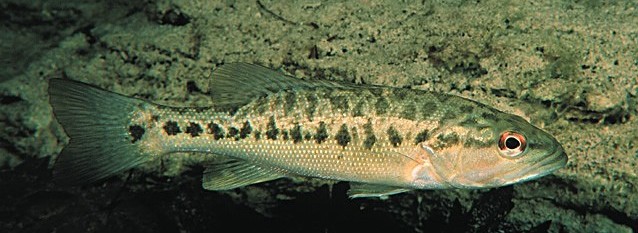
Guadalupe Bass
Warmwater Native Fish Policy Elements
1. FFI supports fisheries management policies and practices that recognize the value and conservation of native warm water species and their habitats. Further, FFI supports management of warm water game fish as self-sustaining wild populations. Therefore, FFI recommends preservation of remaining native warm water fish populations, and supports their expansion into suitable restored habitats.
2. FFI supports the preservation of existing warm water habitat that has shown to be essential for sensitive species such as smallmouth bass, and actively supports the effective control of industrial and agricultural practices that lead or result in habitat degradation and decreased water quality. FFI supports water quality monitoring by FFI members in selected warm water habitats containing sensitive species. Early detection of water quality changes is an FFI goal.
3. Catch and release regulations using single barbless hooks and artificial flies or lures only are an effective management tool for protecting vulnerable or depressed wild populations.
4. FFI advocates development and provision of information materials that will increase angler awareness and understanding of the conservation and recreational values of maintaining native warm water species, the ecological reasons for their preservation.
(1) In this document, the term ‘native’ refers to indigenous species and forms, and does not include non-indigenous naturally reproducing wild fish. Fisheries management throughout most of the 20th century promoted the introduction of non-native fish species. Starting in the late 1970s, managers recognized that these efforts had produced exotic fisheries with considerable recreational value to fishers, but at great expense to many native fish species. Thus, FFI policy, while recognizing the value of these non-native based fisheries, places greater priority on managing and rebuilding fisheries throughout the country that support native fishes in their native habitats. In this context, we treat the terms non-indigenous and exotic as synonymous with non-native.
(2) See FFI Catch and Release Policy. Catch-and-release angling incurs a low level of mortality. Much of this mortality can be further reduced through proper playing, handling, and releasing of hooked fish. Anglers should use heavy enough tackle that the fish can be landed as quickly as possible. Handle the fish as little as possible, keeping it in the water; wet hands or net before landing the fish. Use long-nosed pliers or hemostat to back the hook out of the entrance hole. The use of barbless or circle hooks makes it easier to quickly unhook a fish. Hold the fish gently moving it back and forth until it revives and swims from your hands.
If you would like to print this document you may access the PDF by clicking here.
Please direct questions about the policy should be directed to our Conservation Coordinator.